Tiny 3D Printed Worlds Unveiled in New York City’s Gulliver’s Gate Exhibit
New York is one of the biggest cities in the world, and it contains such a variety of cultures that it can be seen as something of a microcosm of the whole world – and on your next visit to the city, you can literally see the world in miniature. More than 600 artists from around the world have joined forces to build Gulliver’s Gate, a tiny, partially 3D printed world consisting of 300 cities all fitting together in a 4,900-square-foot space in the middle of New York City.
 The project was conceived by Michael Langer, a native New Yorker, and Eiran Gazit, an Israeli who launched a similar project in 2002 called Mini-Israel. Mini-Israel was a bit larger than Gulliver’s Gate; the project was installed in a 14-acre park and contained scale models of various sites in Israel. When Langer and Gazit met, they decided to collaborate on a project that was both bigger and smaller. The buildings, people and natural landscapes of Gulliver’s Gate are built at a 1:87 scale, meaning that a six-foot-tall person would be reduced to 0.8 inches high.
The project was conceived by Michael Langer, a native New Yorker, and Eiran Gazit, an Israeli who launched a similar project in 2002 called Mini-Israel. Mini-Israel was a bit larger than Gulliver’s Gate; the project was installed in a 14-acre park and contained scale models of various sites in Israel. When Langer and Gazit met, they decided to collaborate on a project that was both bigger and smaller. The buildings, people and natural landscapes of Gulliver’s Gate are built at a 1:87 scale, meaning that a six-foot-tall person would be reduced to 0.8 inches high.
Not every single city in the world is included, obviously – that would be a monumental task – but the planet is well-represented with areas depicting New York City itself, Asia, the Middle East, Latin America, Russia, and Europe, plus some fantastical cities. The artists who created the exhibition hail from all over the world, with each of them crafting elements of their own countries of origin (except for, of course, the fantasy areas).
 “I did not want an American to build Jerusalem, I did not want an Italian to build Manhattan,” Gazit told the New York Post. “The reason was to keep it authentic, to keep the flavor, the sound, the humor even. Russian humor is very different from Italian humor.”
“I did not want an American to build Jerusalem, I did not want an Italian to build Manhattan,” Gazit told the New York Post. “The reason was to keep it authentic, to keep the flavor, the sound, the humor even. Russian humor is very different from Italian humor.”
The real places depicted in the miniature world are authentic indeed – Gazit points to an example of a visitor finding a tiny version of a Jerusalem cafe they had recently visited – and rendered in meticulous detail; you can peer through the windows of buildings and see the people inside. It’s not a static exhibit, either – trains zoom across continents while lights flash and music plays (you can go to a tiny Adele concert in London, if you wish). Visitors can interact directly with the exhibit; instead of tickets, they are given keys that allow them to launch airplanes from a futuristic airport or set the Panama Canal into motion. Different time periods are represented, with Roman ruins sharing the space with a futuristic Martian colony.
 3D printing played a large role in the construction of the exhibit, along with more traditional art forms. In fact, for $50, you can have yourself 3D scanned, 3D printed in miniature, and made into a citizen of the Gulliver’s Gate world. That option is limited to early visitors and supporters, at the moment, but the creators plan to continually expand the miniature world every year, populating its new areas with new people. Visitors will also have the option to take their 3D printed mini-selves home with them.
3D printing played a large role in the construction of the exhibit, along with more traditional art forms. In fact, for $50, you can have yourself 3D scanned, 3D printed in miniature, and made into a citizen of the Gulliver’s Gate world. That option is limited to early visitors and supporters, at the moment, but the creators plan to continually expand the miniature world every year, populating its new areas with new people. Visitors will also have the option to take their 3D printed mini-selves home with them.
 Gulliver’s Gate, so named for Jonathan Swift’s Gulliver’s Travels, in which a man stumbles into a world of tiny people among his other adventures, is showing previews from now until May 8. Tickets are $36 for adults and $27 for children and seniors, with special discounts available if you order online. Walking among the minuscule world in Times Square, one might expect to feel quite large in comparison – but, conversely, the scope of the depicted world, and everything happening within it, is also likely to serve the purpose of making us realize just how big our own world really is, and how small we actually are.
Gulliver’s Gate, so named for Jonathan Swift’s Gulliver’s Travels, in which a man stumbles into a world of tiny people among his other adventures, is showing previews from now until May 8. Tickets are $36 for adults and $27 for children and seniors, with special discounts available if you order online. Walking among the minuscule world in Times Square, one might expect to feel quite large in comparison – but, conversely, the scope of the depicted world, and everything happening within it, is also likely to serve the purpose of making us realize just how big our own world really is, and how small we actually are.
Source: 3ders.com










